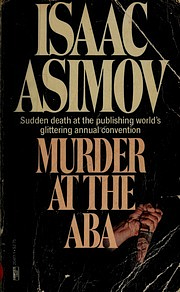You need to sign in or sign up before continuing.
Take a photo of a barcode or cover
Puntuación2.5/5 😑Mej, promedio, decepcionante.
Reto del 2018, around the year in 52 books: #29, relacionado con las armas del juego clue.
Esta es una novela de misterio que se desarrolla durante una convención de editores de libros. Seguimos a nuestro protagonista Darius Just, un escritor que se encarga de investigar el asesinato de una persona durante la convención.
Es una sátira del mundo de editoras, escritores y publicistas. Tiene un tono ligero y por momentos irreverente. Me sorprendió que Asimov escribiera otra cosa que no fuese ciencia ficción. Un aspecto interesante es que el libro utiliza la metaficción, el autor mismo es un personaje de la novela.
El libro es corto pero siento que debe ser aun más corto, se alarga demasiado y resultó canson y aburrido. A mi no me interesó nada, ni quien muere, ni el/la unsub, nada de nada. Me parecía más interesante el mundo y la sátira de ese ambiente literario.
No lo recomiendo.
Reto del 2018, around the year in 52 books: #29, relacionado con las armas del juego clue.
Esta es una novela de misterio que se desarrolla durante una convención de editores de libros. Seguimos a nuestro protagonista Darius Just, un escritor que se encarga de investigar el asesinato de una persona durante la convención.
Es una sátira del mundo de editoras, escritores y publicistas. Tiene un tono ligero y por momentos irreverente. Me sorprendió que Asimov escribiera otra cosa que no fuese ciencia ficción. Un aspecto interesante es que el libro utiliza la metaficción, el autor mismo es un personaje de la novela.
El libro es corto pero siento que debe ser aun más corto, se alarga demasiado y resultó canson y aburrido. A mi no me interesó nada, ni quien muere, ni el/la unsub, nada de nada. Me parecía más interesante el mundo y la sátira de ese ambiente literario.
Spoiler
Asesinaron a Devore, lo hizo el guardia del hotel, Strong porque por confusión le entrego un lapicero lleno de heroína. Strong era parte de una red de distribución de drogas en el hotel.No lo recomiendo.
My mom recommended this book to me because I quite enjoyed all the Sherlock Holmes adventures and I am really happy she did.
This book presents and interesting mystery which is filled with funny moments, and a rather nice ending.
One of the things I appreciate very much about the book is how self-aware it is. The writer shows up as one of the characters and he and the character telling the story "argue"in the foot notes. This addition adds for many funny moments in the book.
Although it is a murder mystery it felt like quite a lighthearted read and I definitely enjoyed it.
This book presents and interesting mystery which is filled with funny moments, and a rather nice ending.
One of the things I appreciate very much about the book is how self-aware it is. The writer shows up as one of the characters and he and the character telling the story "argue"in the foot notes. This addition adds for many funny moments in the book.
Although it is a murder mystery it felt like quite a lighthearted read and I definitely enjoyed it.
mysterious
Plot or Character Driven:
N/A
Strong character development:
No
Loveable characters:
No
Diverse cast of characters:
No
Flaws of characters a main focus:
N/A
This book was DISGUSTING. I read and enjoyed the original Foundation trilogy in my teens and really enjoyed the Elijah Bailey/R. Daneel Olivaw series, so was looking forward to this, but it was sickening. The author comes across as utterly OBSESSED with physical appearance, especially that of women.
Right at the very beginning of the story, the 'narrator' dwells at length on how one woman's choice of dress ended up contributing the the murder:
she was faced with a dilemma. On the one hand, she was young and good-looking and had a body in which all parts fell smoothly into place, so that she had the natural desire to display said body to the world. On the other hand, she was a feminist, and the book she was pushing was feminist, and there was the possibility that to use the lure of the body to promote the book would be a non-feminist thing to do.
I don't know whether she hesitated at all; or if she did, how long. I don't know if she tried on different dresses or settled the matter by pure reason in her mind.
The point is that she ended with a white dress which, above the waistline, was made up of generous swatches of open network, and under it she had above the waistline nothing at all but her own gorgeous self. When she remained in repose, her breasts remained safely behind the small, strategically placed opaque sections. When she raised an arm, as she might, the dress hiked up on that side and one nipple went peek-a-boo.
And it went downhill from there, with phrases like these
Teresa wasn't a bad object for embracing.
How do I describe Roseann? She is not exactly ugly or grotesque, but I think they invented the word "unattractive" for her.
Being among the most 'printable' examples. Every female character without exception is described at length specifically in terms of their physicall attractiveness or lack thereof, and the narrator's louche lasciviousness reminded me of the delightful Spanish expression "viejo verde" Since the who shtick of the book is that it's "meta" because of being written by Asimov and featuring him as a character in the story, I have nocpmunctions in attributing the lecherous misogyny and slurs against everyone from gay people to vegetarians as being reflective of the authors own unpleasant personality. That Asimov acquired a reputation as a gropy old man is one thing, that he wrote a book in which that was on display on almost every page is quite another.
Because of the sheer "ugh" factor, I couldn't focus on the mystery and skimmed this book for two reasons (1) to complete a prompt in the 2023 Onboarding challenge, and (2) to find out whodunnit. What I learned was that a DNF should DEFINITELY be allowed to count for TSG reading challenges.
Right at the very beginning of the story, the 'narrator' dwells at length on how one woman's choice of dress ended up contributing the the murder:
she was faced with a dilemma. On the one hand, she was young and good-looking and had a body in which all parts fell smoothly into place, so that she had the natural desire to display said body to the world. On the other hand, she was a feminist, and the book she was pushing was feminist, and there was the possibility that to use the lure of the body to promote the book would be a non-feminist thing to do.
I don't know whether she hesitated at all; or if she did, how long. I don't know if she tried on different dresses or settled the matter by pure reason in her mind.
The point is that she ended with a white dress which, above the waistline, was made up of generous swatches of open network, and under it she had above the waistline nothing at all but her own gorgeous self. When she remained in repose, her breasts remained safely behind the small, strategically placed opaque sections. When she raised an arm, as she might, the dress hiked up on that side and one nipple went peek-a-boo.
And it went downhill from there, with phrases like these
Teresa wasn't a bad object for embracing.
How do I describe Roseann? She is not exactly ugly or grotesque, but I think they invented the word "unattractive" for her.
Being among the most 'printable' examples. Every female character without exception is described at length specifically in terms of their physicall attractiveness or lack thereof, and the narrator's louche lasciviousness reminded me of the delightful Spanish expression "viejo verde" Since the who shtick of the book is that it's "meta" because of being written by Asimov and featuring him as a character in the story, I have nocpmunctions in attributing the lecherous misogyny and slurs against everyone from gay people to vegetarians as being reflective of the authors own unpleasant personality. That Asimov acquired a reputation as a gropy old man is one thing, that he wrote a book in which that was on display on almost every page is quite another.
Because of the sheer "ugh" factor, I couldn't focus on the mystery and skimmed this book for two reasons (1) to complete a prompt in the 2023 Onboarding challenge, and (2) to find out whodunnit. What I learned was that a DNF should DEFINITELY be allowed to count for TSG reading challenges.
As a mystery, it was OK. But it was diverting, and delightful, because of Asimov’s quirky cleverness.
Darius Just, a second-string writer whose works are just "too good" for the average Joe who wants a good "Best Seller" main stream book, attends the ABA (American Booksellers Association) earlier than planned. His friend asks him to show up a day early to help with a public relations event and thus (in Just's mind at least) starts him down the path that leads to murder. One thing after another happens to put Just in just the right frame of mind to forget another favor that his protégé Giles Devore asks of him. When Devore winds up dead, Just is convinced his sin of omission may have been the catalyst and he sets himself the task of tracking down the killer.
The trouble is, Just and his conscience are the only ones who think there has even been a murder. The hotel security and the police all believe Devore simply slipped in the shower and died when his head met the porcelain. Just spends the rest oft he conference tracking down clues, interviewing (and annoying) possible suspects and witnesses, and basically composing the plot for the mystery novel that the fictional version of Asimov has been commissioned to write. Just's own life will be attempted and his delirious ravings after being coshed on the head himself will lead him to the last clue necessary to trap a murderer.
Back in the mists of time, I read Isaac Asimov's Murder at the ABA (1976; aka Authorised Murder) from either the local Carnegie library or the school library, I'm not sure which. I think I must have been coming off of an Asimov science fiction high, because I gave it a four-star rating. So, it was natural that I'd want a copy of my very own to reread some day. I picked up a copy sometime before 2010 (I didn't log just when) and when one of my fellow challengers read it for my Vintage Bingo Challenge, I decide it was time to pick it up again. I'm afraid I should have left it as a nostalgia piece.
This time around I was not nearly as charmed with Asimov's thinly-disguised Harlan Ellison protagonist, Darius Just nor with Asimov inserting himself into the narrative as comic relief. And I say that as some who is incredibly fond of both Isaac Asimov and Harlan Ellison as writers. Just is annoyingly self-centered, despite his deprecating comments, and the peek at the 1970s treatment of women isn't nearly as amusing as Asimov thinks it is. When you add the fact that the killer (and the reason) is blazingly obvious from the chapter when the body is found (less than half-way through the book), I have to say that Mr. Asimov is not up to his usual standard. His Black Widower tales are much better mystery stories.
★★ for an okay read. IF you manage to miss the clue when Just discovers the body, then it's possible the mystery will entertain--I'm assuming I did miss it back in the 80s. The banter between Asimov and Just, both in the narrative and in the footnotes, is amusing. And the book is a nice look at the 1970s convention/conference scene.
First posted on my blog My Reader's Block. Please request permission before reposting. Thanks.
The trouble is, Just and his conscience are the only ones who think there has even been a murder. The hotel security and the police all believe Devore simply slipped in the shower and died when his head met the porcelain. Just spends the rest oft he conference tracking down clues, interviewing (and annoying) possible suspects and witnesses, and basically composing the plot for the mystery novel that the fictional version of Asimov has been commissioned to write. Just's own life will be attempted and his delirious ravings after being coshed on the head himself will lead him to the last clue necessary to trap a murderer.
Back in the mists of time, I read Isaac Asimov's Murder at the ABA (1976; aka Authorised Murder) from either the local Carnegie library or the school library, I'm not sure which. I think I must have been coming off of an Asimov science fiction high, because I gave it a four-star rating. So, it was natural that I'd want a copy of my very own to reread some day. I picked up a copy sometime before 2010 (I didn't log just when) and when one of my fellow challengers read it for my Vintage Bingo Challenge, I decide it was time to pick it up again. I'm afraid I should have left it as a nostalgia piece.
This time around I was not nearly as charmed with Asimov's thinly-disguised Harlan Ellison protagonist, Darius Just nor with Asimov inserting himself into the narrative as comic relief. And I say that as some who is incredibly fond of both Isaac Asimov and Harlan Ellison as writers. Just is annoyingly self-centered, despite his deprecating comments, and the peek at the 1970s treatment of women isn't nearly as amusing as Asimov thinks it is. When you add the fact that the killer (and the reason) is blazingly obvious from the chapter when the body is found (less than half-way through the book), I have to say that Mr. Asimov is not up to his usual standard. His Black Widower tales are much better mystery stories.
★★ for an okay read. IF you manage to miss the clue when Just discovers the body, then it's possible the mystery will entertain--I'm assuming I did miss it back in the 80s. The banter between Asimov and Just, both in the narrative and in the footnotes, is amusing. And the book is a nice look at the 1970s convention/conference scene.
First posted on my blog My Reader's Block. Please request permission before reposting. Thanks.




